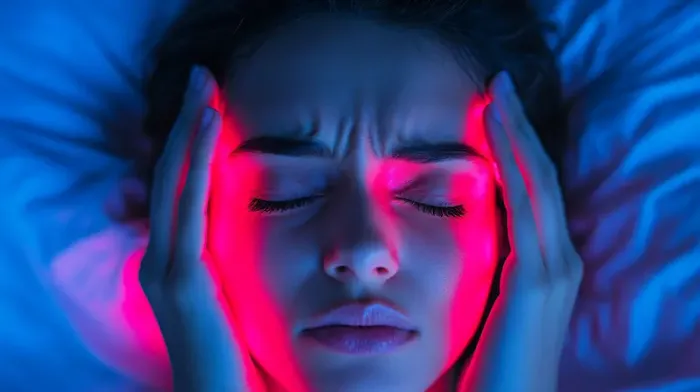Guide to the Connection Between Stress And Migraine
Know about the connection between stress and migraine, how it is linked, stress triggering migraine, tracking stress and migraine patterns and more.

Written by Dr. Md Yusuf Shareef
Reviewed by Dr. D Bhanu Prakash MBBS, AFIH, Advanced certificate in critical care medicine, Fellowship in critical care medicine
Last updated on 28th Oct, 2025

Introduction
If you’ve ever felt a migraine creep in after a hectic week or during a tense deadline, you’ve experienced a classic pattern: the connection between stress and migraine. Stress is one of the most commonly reported migraine triggers, whether it’s an intense day at work, ongoing family pressures, or even the “let-down” period when a busy stretch finally ends. Understanding this connection doesn’t just explain why attacks happen; it gives you practical ways to prevent them, reduce their severity, and regain control.
In this guide, we’ll unpack how stress interacts with migraine biology, what types of stress matter most, and how to spot your personal patterns. You’ll learn evidence-based strategies like mindfulness, cognitive behavioural therapy (CBT), biofeedback, and smart sleep habits—that can lower stress and cut attack frequency. We’ll cover medications, when to see a doctor, and special situations like pregnancy, adolescence, and comorbid anxiety or depression.
Along the way, we’ll offer real-life tips and unique insights not often discussed elsewhere, plus easy-to-understand visuals and quick takeaways. By the end, you’ll know exactly how to leverage the stress–migraine connection to feel and function better.
Why Stress and Migraine Are So Tightly Linked
Stress is frequently cited as the number one migraine trigger in surveys and clinical reports. People often notice that during periods of high demand, looming deadlines, family illness, and financial worries, their migraine attacks become more frequent or intense. Importantly, it isn’t just “bad” stress; even major positive changes (new job, travel, celebrations) can create physiological stress that tips the brain into an attack if the threshold is low.
The “threshold” perspective helps: imagine your brain has a “migraine threshold.” Many factors—sleep, hormones, dehydration, skipped meals, bright light push you closer to or further from it. Stress is a powerful push upward, and when enough triggers pile up, the brain’s pain pathways become activated. This explains why stress can trigger migraine one day but not another: it depends on your overall load.
Migraine: What’s happening in the brain
Migraine is a neurological disorder involving hyperexcitable brain networks, inflammation around pain-sensitive blood vessels, and changes in brainstem and cortical activity. In the early phase, sensory sensitivity increases; pain pathways in the trigeminal system and release of CGRP (calcitonin gene-related peptide) amplify the attack. Stress interfaces with these same pathways, making an attack more likely [3][4].
Stress is the most reported trigger
Large patient surveys consistently rank stress as the most common trigger, often above sleep changes or certain foods. This doesn’t mean stress is the only cause—but it frequently lowers the threshold so other triggers “count” more. Long-tail keyword to note: stress-induced migraine symptoms.
The “let-down” effect after a stressful period
Paradoxically, a migraine may strike when stress drops, like the first day of the weekend or after exams. This “let-down headache” reflects rapid shifts in stress hormones and autonomic balance. Planning preventive habits for the first 24–48 hours post-stress (hydration, consistent meals, earlier bedtime, gentle exercise) can cut risk. Related term: migraine, let-down headache after stress.
How Stress Triggers a Migraine: What Biology Tells Us
Stress affects the brain and body in multiple, overlapping ways that converge on migraine pathways. Understanding the biology helps you see why layered strategies work best.
HPA axis, cortisol, and the migraine threshold
Stress activates the hypothalamic–pituitary–adrenal (HPA) axis, releasing cortisol and other mediators. Short bursts can be adaptive, but chronic activation disrupts circadian patterns, sleep quality, and pain modulation. Dysregulated cortisol may lower the migraine threshold, making an attack more likely when another trigger, like skipped meals or bright light, comes along. For some, the sudden decrease in cortisol after a high-stress period contributes to that “let-down” window. Related term: the cortisol and migraine relationship.
Trigeminovascular activation, CGRP, and inflammation
Migraine involves the trigeminovascular system, where activation leads to the release of CGRP and inflammatory neuropeptides that sensitise pain pathways. Stress can prime these circuits, increasing CGRP release and neuronal hyperexcitability. This is one reason CGRP-targeting preventives (monoclonal antibodies or gepants) can help people whose attacks are stress-sensitive—they dampen the common final pathway.
Sleep, serotonin, and autonomic balance
Stress interferes with deep sleep and REM architecture, pushes late-night screen time, and fuels inconsistent schedules—all known migraine drivers. It also shifts serotonin and noradrenaline signalling, which regulate pain and vascular tone. Autonomic imbalance (reduced parasympathetic “rest and digest,” elevated sympathetic “fight or flight”) can be tracked by heart rate variability (HRV). Low HRV is associated with higher stress and, in some migraineurs, more frequent attacks. Long-tail term: how does stress trigger migraines?
Not All Stress Is the Same: Different Types, Different Impacts
Different stressors influence migraine differently. Recognising your specific patterns helps you apply the right solution.
Acute vs. chronic stress, and why chronic matters more
Acute stress:
Sudden deadlines, arguments, intense workouts. Can trigger same-day attacks, especially with dehydration or skipped meals.
Chronic stress:
Ongoing job strain, caregiving, and financial insecurity. Chronic activation of stress pathways erodes sleep quality and resilience, often increasing monthly migraine days and risk of medication-overuse headache (MOH) over time.
Work strain, emotional load, and timing of attacks
Work and school stress commonly cluster attacks toward late afternoon or early evening. Emotional stress (grief, conflict) may produce more prolonged prodrome (yawning, neck stiffness, cravings) before the headache phase, offering an early intervention window. For some, the post-stress let-down triggers attacks on Fridays or the first holiday day.
Lifestyle factors that amplify stress-triggered migraine
Sleep variability:
Weekend “catch-up” sleep can precipitate let-down attacks.
Caffeine timing: Large swings (none vs. several cups) destabilise the nervous system. Consistency helps.
Screen and light exposure:
Bright, flickering, or late-night blue light is both a stressor and a trigger. Use night filters and scheduled breaks.
Dehydration and meal gaps:
Compound stress-related hormonal effects; plan portable snacks and a water bottle.
Find Your Pattern: Tracking the Stress–Migraine Connection
Good tracking converts vague hunches into actionable patterns.
Using a migraine diary or app effectively
Record:
Date/time, intensity, duration
Warning signs (prodrome): yawning, food cravings, mood change
Stress level (0–10 scale) twice daily
Sleep duration and regularity
Caffeine, meals, hydration
Menstrual phase (if applicable)
Acute medications (what, dose, time)
Two to four weeks of data often reveal clear links—like attacks after short sleep plus high stress.
What to track: stress, sleep, food, hormones, and screens
Add small experiments:
Move caffeine earlier and keep the dose steady for 2 weeks.
Fix meal timing within a 12-hour window (e.g., 8 am–8 pm).
Insert two 2-minute breathing breaks (late morning, late afternoon) on stressful days; see if attacks shift.
Use a blue-light filter and stop screens 60 minutes before bed.
When data suggest medical evaluation or lab tests
Consider medical input if you notice:
Increasing frequency (e.g., 8 or more headache days per month)
Attacks that don’t respond to usual meds
Red flags: sudden “worst headache,” new neurological symptoms, fever, head injury
Suspected comorbidities: sleep apnea, anxiety/depression, neck issues, medication-overuse
If your condition does not improve after trying these methods, book a physical visit to a doctor with Apollo24|7. If symptoms persist beyond two weeks or you cross 4–8 migraine days per month, consult a doctor online with Apollo 24|7 for further evaluation. In some cases, checking vitamin D, thyroid function, iron studies, or HbA1c is useful to rule out contributors; Apollo 24|7 offers convenient home collection for tests like vitamin D or HbA1c.
Reduce Stress, Reduce Attacks: Strategies That Work
Evidence supports several behavioural treatments that both lower stress and reduce migraine frequency. Combining methods often works best.
Mindfulness, CBT, biofeedback, and relaxation training
Mindfulness-based stress reduction (MBSR): Can reduce headache days and improve quality of life by training non-reactivity to sensations and thoughts.
Cognitive behavioural therapy (CBT): Targets stress appraisals, catastrophic thinking, and avoidance. Helpful when anxiety or low mood co-exist.
Biofeedback: Teaches control over physiologic markers (muscle tension, skin temperature, heart rate variability). EMG and thermal biofeedback have shown reductions in migraine frequency and intensity in clinical studies [1][5]. Related term: biofeedback for migraine prevention.
Progressive muscle relaxation (PMR) and paced breathing (e.g., 4-7-8): Simple, home-based, effective for downshifting the nervous system.
Exercise, breathing, and micro-breaks at work - Aerobic exercise 3x/week (e.g., brisk walking, cycling) is comparable to some preventives in small trials, with added mood/sleep benefits.
Two-minute “micro-breaks” every 60–90 minutes: stand, stretch, diaphragmatic breathing, look at a distant point to reduce visual strain.
“Gate the day” breathing: 2 minutes mid-morning and mid-afternoon. This anticipates stress spikes that often precede attacks.
Building a daily “migraine resilience” routine
Regular sleep: fixed wake time 7 days/week; wind-down routine; dark, cool bedroom.
Consistent meals and hydration: pair each caffeine serving with a glass of water; avoid long gaps.
Light hygiene: dimmer lights after sunset; use screen filters.
Social support: quick check-ins reduce perceived stress; consider a buddy system at work or home.
Treatment Options and When to See a Doctor
Effective migraine care blends self-management with the right medication plan. This is especially important when stress is a prominent trigger.
Acute treatments and how to use them well
NSAIDs (e.g., naproxen), triptans, ditans, and gepants are standard acute options. Taking them early—at the first sign of headache or during prodrome—improves success [4].
Anti-nausea meds (e.g., metoclopramide) help if nausea delays absorption.
Hydration, a dark room, and a brief nap can support recovery.
Avoid medication-overuse headache (MOH): Regularly using acute meds on >10 days/month for triptans/ditans/gepants or >15 days/month for NSAIDs can worsen headaches over time. Track usage and set guardrails.
Preventive options, comorbidity care, and MOH prevention
Preventives: beta-blockers, topiramate, tricyclics, onabotulinumtoxinA (chronic migraine), and CGRP monoclonal antibodies or gepants can reduce monthly migraine days and blunt stress-sensitivity [3][4].
If anxiety/depression co-exist, SNRIs or certain TCAs may help both conditions. Always review risks/benefits with a clinician.
Behavioural preventives (CBT, biofeedback, mindfulness) enhance medication benefits and reduce reliance on acute meds [5].
When to consult a clinician and what to ask
Seek care if attacks are frequent (≥4 migraine days/month), disabling despite acute therapy, or if red flags appear (sudden severe headache, neurological deficits, new headaches after age 50). If symptoms persist beyond two weeks or you’re unsure which treatment fits you, consult a doctor online with Apollo24|7 for further evaluation.
Special Considerations and Real-life Scenarios
Different life stages and contexts change how the stress–migraine connection shows up.
Children/teens, pregnancy, and perimenopause
Children/teens: School stress, screens, and sports schedules are common triggers. Emphasise sleep routine, hydration, and structured downtime. Behavioural therapies are first-line; medication choices differ by age—see a pediatric clinician [3].
Pregnancy: Many improve after first trimester; others don’t. Non-drug strategies are key; medication options must be reviewed for safety. Consult your obstetric provider.
Perimenopause: Hormonal variability plus stress can increase attacks. Consistent sleep and exercise help; discuss hormone-sensitive treatment strategies with your clinician.
Anxiety, depression, and trauma-informed care
Migraine commonly co-occurs with anxiety and depression, each amplifying stress and attack risk. Integrated care—CBT or other psychotherapy, exercise, targeted medications—can lower both stress and migraine frequency. Trauma history may heighten stress reactivity; a trauma-informed clinician can tailor strategies safely..
Conclusion
The stress–migraine connection is real, common, and—importantly—manageable. Stress doesn’t “cause” migraine by itself; it interacts with your brain’s threshold along with sleep, light, hydration, and hormonal factors. That’s why a layered approach works best. Start by tracking your pattern for a few weeks to see when stress pushes you closest to the threshold. Then build daily “resilience deposits”: a consistent wake time, regular meals, hydration, and two short breathing or relaxation breaks—especially before known stress spikes or the “let-down” period after them.
When attacks occur, treat early and smartly, and pair your acute plan with a short recovery routine. If you’re having four or more migraine days a month, or attacks remain disabling, discuss preventive options and behavioural therapies with a clinician. If your condition does not improve after trying these methods, book a physical visit to a doctor with Apollo24|7; if you need timely guidance, consult a doctor online with Apollo24|7. Where appropriate, simple lab checks (like vitamin D or thyroid function) can rule out contributors, and Apollo24|7 offers convenient home collection.
More articles from Stress
Frequently Asked Questions
1) Can anxiety cause migraine attacks?
Anxiety doesn’t directly cause migraine, but it heightens stress reactivity and lowers the migraine threshold, increasing attack likelihood. Treating anxiety (CBT, exercise, and appropriate medications) often reduces migraine frequency.
2) What is a “let-down” migraine after stress?
It’s an attack that occurs when stress suddenly drops—like the first day off after a busy week. Plan extra sleep, regularity, hydration, and gentle activity during this window to reduce risk. Related term: migraine, let-down headache after stress.
3) Which relaxation techniques work best for stress-induced migraine symptoms?
Progressive muscle relaxation, diaphragmatic breathing, guided imagery, and mindfulness are well-studied. Try 10 minutes daily and add 2-minute “micro-breaks” during stressful periods. Related term: relaxation techniques for migraine relief.
4) How do I know when to see a doctor for migraines?
If you have ≥4 migraine days/month, need acute meds more than 10 days/month (or NSAIDs >15), or your headaches are worsening or atypical, see a clinician. If symptoms persist beyond two weeks, consult a doctor online with Apollo24|7 for further evaluation.
5) Do CGRP medications help migraines triggered by stress?
.CGRP monoclonal antibodies and gepants target a key migraine pathway and can reduce monthly migraine days, including in people with stress-sensitive attacks. Discuss risks, benefits, and fit with your clinician. Related term: CGRP and stress in migraine.




